Oldsmobile Cutlass Supreme 1995 Owner's Manuals
Manufacturer: OLDSMOBILE, Model Year: 1995, Model line: Cutlass Supreme, Model: Oldsmobile Cutlass Supreme 1995Pages: 340, PDF Size: 16.68 MB
Page 161 of 340

Driving on Snow or Ice
Most of the time, those places where your tires meet the
road probably have good traction. least traction
of all.
You can get “wet ice” when it’s
about freezing
(32°F; OOC) and freezing rain begins to
fall. Try to avoid driving on wet ice until salt and sand
crews can get there.
road.
Watch for slippery spots. The road might be fine
until you
hit a spot that’s covered with ice. On an
otherwise clear road, ice patches may appear in
shaded areas where the sun can’t reach: around
clumps of trees, behind buildings, or urider bridges.
Sometimes the surface of a curve or an averpass may
remain icy when the. surrounding roads
are clear. If
too. fast, the drive wheels will spin and polish the surface
under the tires even more.
‘Your anti-lokk brakes improve your ability to make a
hard stop
on a slippery road. Even though you have the
anti-lock braking system, you’ll want to begin stopping
sooner than you would on dry pavement. See
“Anti-Lock”
in the Index.
Allow greater following distance on any slippery
What’s the worst time for this? “Wet ice.”
V&y cold
snow or ice can be slick and hard to drive on. But wet
ice can be even more, trouble because
it may offer the you
see a-patch of ice ahead of you, brake before you
are on it. Try not
to brake while you’re actually on
the ice, and avoid‘sudden steering maneuvers.
4-23 .
Page 162 of 340
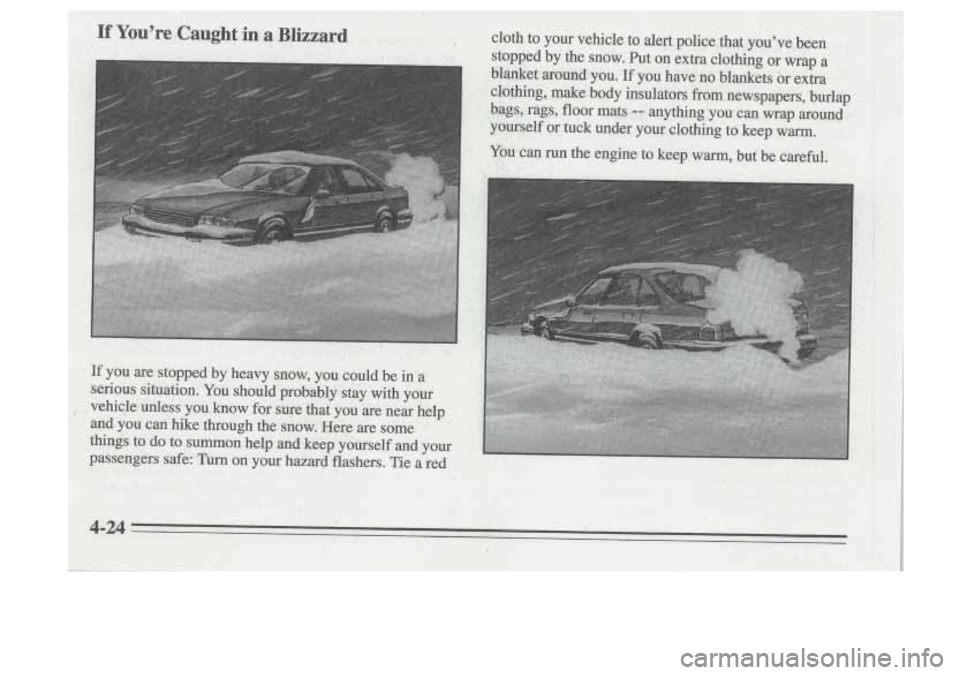
Page 163 of 340

Page 164 of 340
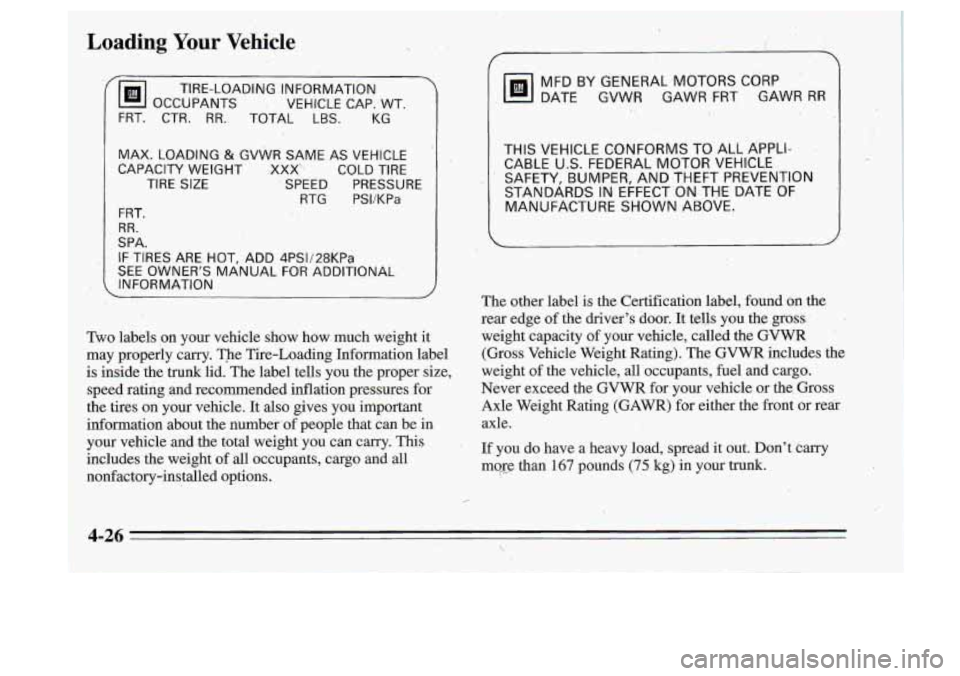
( @ TIRE-LOADING
OCCUPANTS VE’HICLE CAP., WT.
INFORMATION
FRT. CTR.
RR. TOTAL LBS. KG~
I
MAX. LOADING-& GVWR SAME AS VEHICLE
CAPACITY WEIGHT
.XXX’. COLD TIRE
TIRE
SIZE SPEED PRESSURE RTG
PSI/KPa
I
IF TIRES ARE HOT, ADD 4PSI/28KPa
SEE OWNER’S MANUAL FOR ADDITIONAL
INFORMATION
4-26
MFD BY GENERAL MOTORS CORP
THIS VEHICLE CONFORMS TO ALL APPLI-
CABLE U.S. FEDERAL MOTOR VEHICLE
’ SAFETY, BUMPER, AND THEFT PREVENTION
STANDARDS
IN EFFECT ON.THE DATE OF
MANUFACTURE SHOWN ABOVE.
Two labelspn your vehicle show how much weight it
may properly carry. The Tire-Loading Information label
is inside the trunk lid. The label tells you the proper size,
speed rating and recommended inflation pressures for
the tires
on your vehicle. It also gives you important
information about the number‘of people that can be
in
your vehicle and .the total weight you can carry. This
includes the weight of all occupants, cargo and all
--
nonfactory-installed options. The
other 1abel.is the Certification label, found on the
rear edge of the driver’s door.
It tells you the gross.’
weight capacity of your vehicle, called the
GVWR . .
(Gross Vehicle Weight Rating). The GVWR includes the
weight
of the vehicle, all occupants, fuel and cargo.
Never exceed the
GVWR for your vehicle or the Gross
Axle Weight Rating (GAWR) for either the front or re*
axle.
If you do have a heavy load, spread it out. Don’t carry
mop than 167 pounds (75 kg) in your trunk.
Page 165 of 340
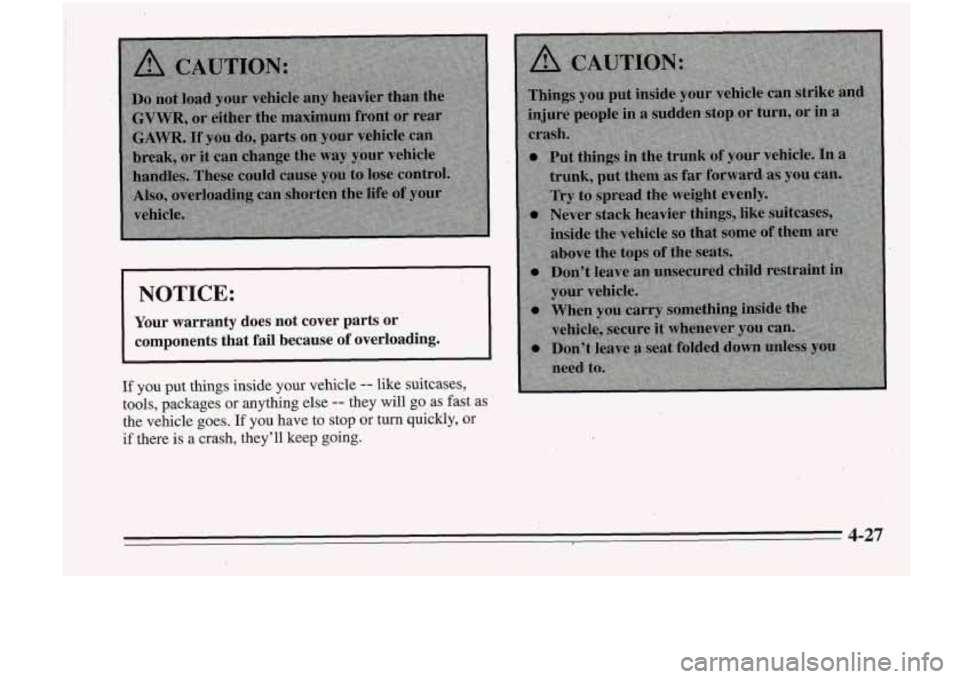
NOTICE:
Your warranty does not cover parts or
components that, fail because of overloading.
If you put things inside your vehicle -- like suitcases,
tools, packages
or anything else -- they .will go as fast as
the vehicle goes.
If you have to stop or turn quickly, or
if there is a crash, they’ll keep going.
4-27 I
I
Page 166 of 340
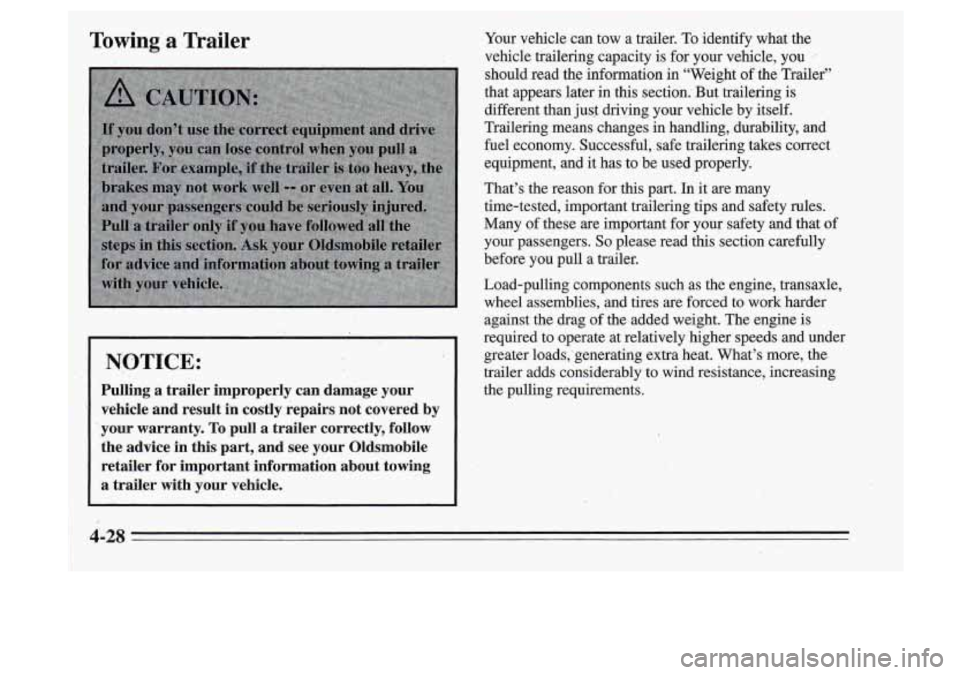
NOTICE:
Pulling a trailer improperly can damage your vehicle and resalt
in costly repairs not covered by
jour warranty.
To pull a trailer correctly, follow
the advice in this part, and see your Oldsmobile
retailer for important information about towing a trailer with your vehicle.
Page 167 of 340
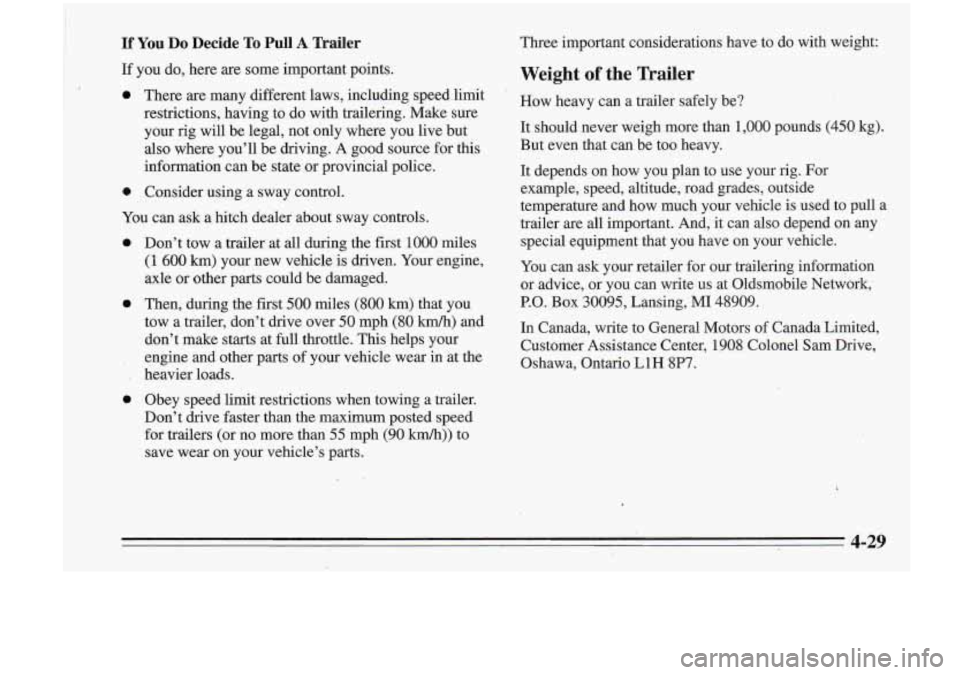
I
I
If You Do Decide To Pull A Trailer
If you do, here are some important points.
0 There are may different laws, including speec i limit
restrictions, having to do with trailering. Make sure
your rig will be legal, not only where you live but
also where you’ll be driving. A good source for this
information can be state or provincial police.
0 Consider using a sway control.
You can ask a hitch dealer about sway controls.
0
0
0
Don’t tow a trailer at all during the first 1000 miles
(1
600 km) your new vehicle is driven. Your engine,
axle or other parts could be damaged.
Then, during
the first 500 miles (800 km) that you
tow a trailer, don’t drive over
50 mph (80 km/h) and
don’t make starts at, full throttle. This helps your
engine and other parts of your vehicle wear in at the
heavier loads.
Obey speed limit restrictions when towing a trailer.
Don’t
drive faster than the’maximum posted speed
for trailers (or no more than 55 mph (90 km/h)) to
save wear on your vehicle’s parts. Three important
considerations have to do with weight:
Weight of the Trailer
How heavy can a trailer safely be?
It should never weigh more than 1,000 pounds
(450: kg).
But even that can be too heavy.
It depends on how you plan to use your rig.
For
example, speed, altitude, road grades, outside
temperature and how much your vehicle is, used to pull
a
trailer are all important. And, it can also depend on any
special equipment that you have on your vehicle.
You can ask your retailer for our trailering information
or advice, or
you can write us at Oldsmobile Network,.
P.O. Box 30095, Lansing, MI 48909.
In Canada, write to General Motors of Canada Limited,
Customer Assistance Center, 1908 Colonel
Sam Drive,
Oshawa, Ontario LlH
8P7.
4-29
I
Page 168 of 340
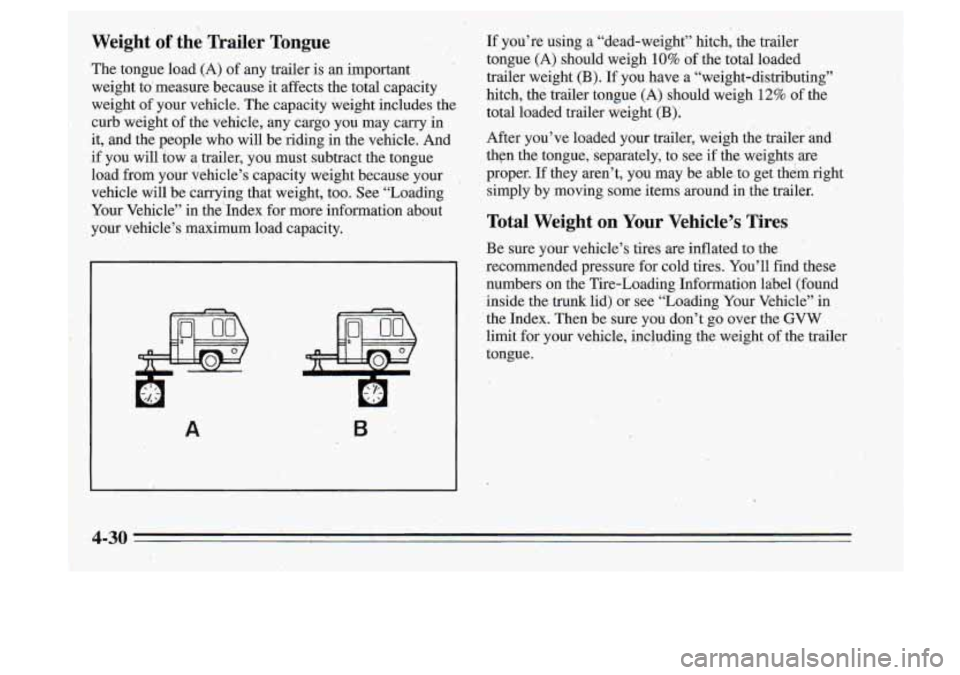
Weight of the Trailer Tongue -. <
The tongue load (A) of any trailer is an important
weight to’ measure because it affects the total capacity
weight
of your‘vehicle. The capaci,ty weight includes the
curb weight
of the vehicle, any cargo you may carry in
it, and the people who will be riding
in the vehicle. And
if you will tow a trailer, you must subtract the tongue
load from your vehicle’s capacity weight because your
vehicle will be carrying that weight, too. See “Loading
Your Vehicle” in the’ Index for .more information about
your vehicle% maximum load capacity.
A
I
Page 169 of 340

Hitches
It’s important to have the correct hitch equipment.
Crosswinds, large trucks going by, and rough roads are
a
few reasons why you’ll need’the right hitch. Here are
some rules to follow:
0
0
Will you have to make any holes in the body of your
vehicle when you install a:trader hitch?
If you do,
then be sure to seal the holes later when you remove
the hitch.
If you don’t seal them, deadly carbon
monoxide (CO) from your exhaust can get into your
vehicle (see “Carbon Monoxide”
in the Index). Dirt
and water can, too.
The bumpers on your vehicle are not intended for
hitches. Do not attach rental lvtches or other
bumper-type hitches to them. Use only a
frsune-mounted hitch that does not attach to the
bumper.
Safety Chains
You should always attach chains between your vehicle
and your trailer. Cross the safety chains under the tongue
of the trailer
so that the tongue will not drop to the road
if it becomes separated from the.hitch. Instructions
about safety chains may be provided by the hitch
manufacturer or by the trailer manufacturer. Follow the
manufacturer’s recommendation
for attaching safety
chains and do not attach them to‘the bumper. Always
leave just enough slack
so you can turn with your rig.
And, never allow safety chains to drag on the ground.
Trailer Brakes
Because you have anti-lock brakes, do not try to tap into
your vehicle’s brake system.
If you do, both brake
systems won’t work well, or at all.
Page 170 of 340

-
I
,'
Driving with a Trailer Following Distance
Towing a trailer requires a certain amount
of experience. Stay at least twice as far behind the vehicle .ahead as- you - .
Before setting out for the open road, you'll want to get would when driving your veh\
icle without a trailer. This$,
to know your rig. AcquQint yourself with the feel of can help you avoid situations that require heavy br-it
and sudden turns.
handling and braking with the added weight of the
trailer. And always keep in mind that ,the vehicle you are
driving is now a good deal longer
and not nearly as . Passing
responsive as your vehicle is by itself. You'll need more passing distance up ahead when
Before you start, check the.trailer hitch and platform you're' towing a trailer. And, because you're a good deal
(and attachments), safety chains, electrical connector, longer, \
you'll need to go much farther beyond the
lights, tires and mirror adjustment.
If the trailer has passed vehicle before you can return to your \
lane.
electric brakes, start your vehicle and trailer moving and
the brakes are working. This lets you check ,your Hold the bottom
of the steering wheel with one hand.
electrical connection at the same time. Then, to move the trailer
to the left, just move that hand
During your
trip, check occasionally to' be sure that the to the left.
To move the trailer to the right, move your
load is secure, and that the lights and any trailer brakes hand to the right. Always back up slowly and, if
are still working. possible. have someone guide you.
.. . ~.
then apply the trailer brake controller by hand to be sure Backing Up
?'